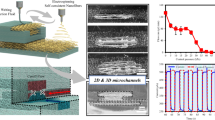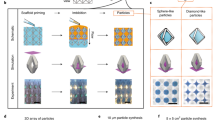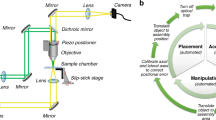Abstract
Fluidic self-assembly is a promising pathway for parallel fabrication of devices made up of many small components. Here, we introduce ‘railed microfluidics’ as an agile method to guide and assemble microstructures inside fluidic channels. The guided movement of microstructures in microfluidic channels was achieved by fabricating grooves (‘rails’) on the top surface of the channels and also creating complementary polymeric microstructures that fit with the grooves. Using the rails as a guiding mechanism, we built complex one- and two-dimensional microsystems in which all the microstructures initially involved in the fabrication method were incorporated as components in the final product. Complex structures composed of more than 50 microstructures (each sized smaller than 50 μm) were fluidically self-assembled with zero error. Furthermore, we were able to use the rails to guide microstructures through different fluid solutions, successfully overcoming strong interfacial tension between solutions. On the basis of rail-guided self-assembly and cross-solution movement, we demonstrated heterogeneous fluidic self-assembly of polymeric microstructures and living cells. In addition to such assembly of in situ polymerized structures, we also guided and assembled externally fabricated silicon chips—demonstrating the feasible application of railed microfluidics to other materials systems.
This is a preview of subscription content, access via your institution
Access options
Subscribe to this journal
Receive 12 print issues and online access
$259.00 per year
only $21.58 per issue
Buy this article
- Purchase on Springer Link
- Instant access to full article PDF
Prices may be subject to local taxes which are calculated during checkout





Similar content being viewed by others
References
Morris, C. J., Stauth, S. A. & Parviz, B. A. Self-assembly for microscale and nanoscale packaging: Steps toward self-packaging. IEEE Trans. Adv. Packaging 28, 600–611 (2005).
Whitesides, G. M. & Grzybowski, B. Self-assembly at all scales. Science 295, 2418–2421 (2002).
Yeh, H. J. & Smith, J. S. Fluidic self-assembly for the integration of GaAs light-emitting diodes on Si substrates. IEEE Photon. Technol. Lett. 6, 706–708 (1994).
Snyder, E. J., Chideme, J. & Craig, G. S. W. Fluidic self-assembly of semiconductor devices: A promising new method of mass-producing flexible circuitry. Jpn. J. Appl. Phys. 41, 4366–4369 (2002).
Hulteen, J. C. & Duyne, R. P. V. Nanosphere lithography: A materials general fabrication process for periodic particle array surfaces. J. Vac. Sci. Technol. 13, 1553–1558 (1995).
Ormonde, A. D., Hicks, E. C. M., Castillo, J. & Duyne, R. P. V. Nanosphere lithography: Fabrication of large-area Ag nanoparticle arrays by convective self-assembly and their characterization by scanning UV–visible extinction spectroscopy. Langmuir 20, 6927–6931 (2004).
Dendukuri, D., Hatton, T. A. & Doyle, P. S. Synthesis and self-assembly of amphiphilic polymeric microparticles. Langmuir 23, 4669–4674 (2007).
Boote, J. J., Critchley, K. & Evans, S. D. Surfactant mediated assembly of gold nanowires on surfaces. J. Exp. Nanosci. 1, 125–142 (2006).
Tanase, M. et al. Magnetic trapping and self-assembly of multicomponent nanowires. J. Appl. Phys. 91, 8549–8551 (2002).
Huang, Y., Duan, X., Wei, Q. & Lieber, C. M. Directed assembly of one-dimensional nanostructures into functional networks. Science 291, 630–633 (2001).
Salalha, W. & Zussman, E. Investigation of fluidic assembly of nanowires using a droplet inside microchannels. Phys. Fluids 17, 063301 (2005).
Stauth, S. A. & Parviz, B. A. Self-assembled single-crystal silicon circuits on plastic. Proc. Natl Acad. Sci. 103, 13922–13927 (2006).
Gracias, D. H., Tien, J., Breen, T. L., Hsu, C. & Whitesides, G. M. Forming electrical networks in three dimensions by self-assembly. Science 289, 1170–1172 (2000).
Scott, K. L. et al. High-performance inductors using capillary based fluidic self-assembly. J. Microelectromech. Syst. 13, 300–309 (2004).
Srinivasan, U., Liepmann, D. & Howe, R. T. Microstructure to substrate self-assembly using capillary forces. J. Microelectromech. Syst. 10, 17–24 (2001).
Jacobs, H. O., Tao, A. R., Schwartz, A., Gracias, D. H. & Whitesides, G. M. Fabrication of a cylindrical display by patterned assembly. Science 296, 323–325 (2002).
Smith, J. S. Fluidic self-assembly of active antenna. US patent 6,611,237 (2003).
Lu, Y., Yin, Y. & Xia, Y. A self-assembly approach to the fabrication of patterned, two-dimensional arrays of microlenses of organic polymers. Adv. Mater. 13, 34–37 (2001).
Xia, Y., Yin, Y., Lu, Y. & McLellan, J. Template-assisted self-assembly of spherical colloids into complex and controllable structures. Adv. Funct. Mater. 13, 907–918 (2003).
Rothemund, P. W. K. Folding DNA to create nanoscale shapes and patterns. Nature 440, 297–302 (2006).
Stroock, A. D., Dertinger, S. K., Whitesides, G. M. & Ajdari, A. Patterning flows using grooved surfaces. Anal. Chem. 74, 5306–5312 (2002).
Chung, S. E. et al. Optofluidic maskless lithography system for real-time synthesis of photopolymerized microstructures in microfluidic channels. Appl. Phys. Lett. 91, 041106 (2007).
Dendukuri, D., Pregibon, D. C., Collins, J., Hatton, T. A. & Doyle, P. S. Continuous-flow lithography for high-throughput microparticle synthesis. Nature Mater. 5, 365–369 (2006).
Koh, W. G., Revzin, A. & Pishko, M. V. Poly(ethylene glycol) hydrogel microstructures encapsulating living cells. Langmuir 18, 2459–2462 (2002).
Koh, W. G., Itle, L. J. & Pishko, M. V. Molding of hydrogel microstructures to create multiphenotype cell microarrays. Anal. Chem. 75, 5783–5789 (2003).
Liu, V. A. & Bhatia, S. N. Three-dimensional photopatterning of hydrogels containing living cells. Biomed. Microdev. 4, 257–266 (2002).
El-Ali, J., Sorger, P. K. & Jensen, K. F. Cells on chips. Nature 442, 403–411 (2006).
Yeh, J. et al. Micromolding of shape-controlled, harvestable cell-laden hydrogels. Biomaterials 27, 5391–5398 (2006).
Albrecht, D. R., Tsang, V. L., Sah, R. L. & Bhatia, S. N. Photo-and electropatterning of hydrogel-encapsulated living cell arrays. Lab Chip 5, 111–118 (2005).
Acknowledgements
This work was partly supported by the System IC 2010 project of the Ministry of Knowledge Economy and the Nano Systems Institute National Core Research Center (NSI-NCRC) program of KOSEF. We thank M.-O. Lee of the College of Pharmacy, SNU, for providing the cell line.
Author information
Authors and Affiliations
Corresponding author
Supplementary information
Supplementary Information
Section S1–S3 (PDF 313 kb)
Supplementary Information
Supplementary Movie S1 (MOV 3937 kb)
Supplementary Information
Supplementary Movie S2 (MOV 4858 kb)
Supplementary Information
Supplementary Movie S3 (MOV 3738 kb)
Supplementary Information
Supplementary Movie S4 (MOV 2208 kb)
Supplementary Information
Supplementary Movie S5 (MOV 577 kb)
Rights and permissions
About this article
Cite this article
Chung, S., Park, W., Shin, S. et al. Guided and fluidic self-assembly of microstructures using railed microfluidic channels. Nature Mater 7, 581–587 (2008). https://doi.org/10.1038/nmat2208
Received:
Accepted:
Published:
Issue Date:
DOI: https://doi.org/10.1038/nmat2208
This article is cited by
-
Colloidal robotics
Nature Materials (2023)
-
Rail induced lateral migration of particles across intact co-flowing liquids
Scientific Reports (2022)
-
Production of hydrogel microparticles in microfluidic devices: a review
Microfluidics and Nanofluidics (2021)
-
Microsized 3D Hydrogel Printing System using Microfluidic Maskless Lithography and Single Axis Stepper Motor
BioChip Journal (2020)
-
Geometric Determinants of In-Situ Direct Laser Writing
Scientific Reports (2019)



